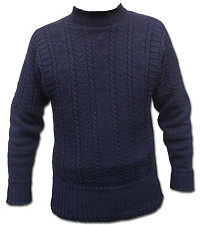Wiska

Traditional wiska.

Gansey. Photo from Flamborough Marine.
We have some curious looking things in the museum. This is one of them. It’s a leather belt with a padded pouch. The pouch is stuffed with horsehair, and its leather covering is dotted with holes.
It is a knitting belt or ‘Wiska’, probably dating from the late 19th century. Double-ended knitting needles were poked into the holes in the pouch. There are two main advantages to using a wiska while knitting. If a knitting needle is held by the wiska, it takes a lot of the weight – this is very helpful when the garment is nearly finished and therefore heavy. Also, the wiska allows the knitter to continue to knit while moving around – no need to sit down and knit.
Wiskas were common in fishing communities where women used to knit jumpers for their menfolk. There was a strong tradition of making these jumpers, known as ‘ganseys’, in coastal communities in eastern England and Scotland. Knitters further inland appreciate their use too.
A gansey does not have side seams, and the body of the gansey, and also its sleeves, are knitted as tubes. Made from sheep’s wool, and with a very tight mesh, ganseys give protection from wind and water.
Should you be uncertain about how a wiska is used, there are helpful online videos. Search for ‘using a knitting belt’!
Our wiska was donated by Mrs Jennifer Smith whose husband’s ancestors worked with the herring fleet along the coast.